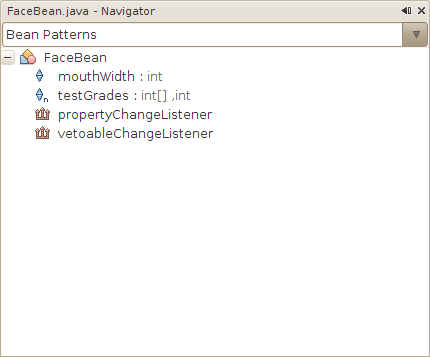Lesson: Writing JavaBeans Components
The Java Tutorials have been written for JDK 8. Examples and practices described in this page don't take advantage of improvements introduced in later releases and might use technology no longer available.
See Java Language Changes for a summary of updated language features in Java SE 9 and subsequent releases.
See JDK Release Notes for information about new features, enhancements, and removed or deprecated options for all JDK releases.
Properties
To define a property in a bean class, supply public getter and setter methods. For example, the following methods define an int property called mouthWidth:
public class FaceBean {
private int mMouthWidth = 90;
public int getMouthWidth() {
return mMouthWidth;
}
public void setMouthWidth(int mw) {
mMouthWidth = mw;
}
}
A builder tool like NetBeans recognizes the method names and shows the mouthWidth property in its list of properties. It also recognizes the type, int, and provides an appropriate editor so the property can be manipulated at design time.
This example shows a property than can be read and written. Other combinations are also possible. A read-only property, for example, has a getter method but no setter. A write-only property has a setter method only.
A special case for boolean properties allows the accessor method to be defined using is instead of get. For example, the accessor for a boolean property running could be as follows:
public boolean isRunning() {
// ...
}
Various specializations of basic properties are available and described in the following sections.
Indexed Properties
An indexed property is an array instead of a single value. In this case, the bean class provides a method for getting and setting the entire array. Here is an example for an int[] property called testGrades:
public int[] getTestGrades() {
return mTestGrades;
}
public void setTestGrades(int[] tg) {
mTestGrades = tg;
}
For indexed properties, the bean class also provides methods for getting and setting a specific element of the array.
public int getTestGrades(int index) {
return mTestGrades[index];
}
public void setTestGrades(int index, int grade) {
mTestGrades[index] = grade;
}
Bound Properties
A bound property notifies listeners when its value changes. This has two implications:
- The bean class includes
addPropertyChangeListener()andremovePropertyChangeListener()methods for managing the bean's listeners. - When a bound property is changed, the bean sends a
PropertyChangeEventto its registered listeners.
PropertyChangeEvent and PropertyChangeListener live in the java.beans package.
The java.beans package also includes a class, PropertyChangeSupport, that takes care of most of the work of bound properties. This handy class keeps track of property listeners and includes a convenience method that fires property change events to all registered listeners.
The following example shows how you could make the mouthWidth property a bound property using PropertyChangeSupport. The necessary additions for the bound property are shown in bold.
import java.beans.*;
public class FaceBean {
private int mMouthWidth = 90;
private PropertyChangeSupport mPcs =
new PropertyChangeSupport(this);
public int getMouthWidth() {
return mMouthWidth;
}
public void setMouthWidth(int mw) {
int oldMouthWidth = mMouthWidth;
mMouthWidth = mw;
mPcs.firePropertyChange("mouthWidth",
oldMouthWidth, mw);
}
public void
addPropertyChangeListener(PropertyChangeListener listener) {
mPcs.addPropertyChangeListener(listener);
}
public void
removePropertyChangeListener(PropertyChangeListener listener) {
mPcs.removePropertyChangeListener(listener);
}
}
Bound properties can be tied directly to other bean properties using a builder tool like NetBeans. You could, for example, take the value property of a slider component and bind it to the mouthWidth property shown in the example. NetBeans allows you to do this without writing any code.
Constrained Properties
A constrained property is a special kind of bound property. For a constrained property, the bean keeps track of a set of veto listeners. When a constrained property is about to change, the listeners are consulted about the change. Any one of the listeners has a chance to veto the change, in which case the property remains unchanged.
The veto listeners are separate from the property change listeners. Fortunately, the java.beans package includes a VetoableChangeSupport class that greatly simplifies constrained properties.
Changes to the mouthWidth example are shown in bold:
import java.beans.*;
public class FaceBean {
private int mMouthWidth = 90;
private PropertyChangeSupport mPcs =
new PropertyChangeSupport(this);
private VetoableChangeSupport mVcs =
new VetoableChangeSupport(this);
public int getMouthWidth() {
return mMouthWidth;
}
public void
setMouthWidth(int mw) throws PropertyVetoException {
int oldMouthWidth = mMouthWidth;
mVcs.fireVetoableChange("mouthWidth",
oldMouthWidth, mw);
mMouthWidth = mw;
mPcs.firePropertyChange("mouthWidth",
oldMouthWidth, mw);
}
public void
addPropertyChangeListener(PropertyChangeListener listener) {
mPcs.addPropertyChangeListener(listener);
}
public void
removePropertyChangeListener(PropertyChangeListener listener) {
mPcs.removePropertyChangeListener(listener);
}
public void
addVetoableChangeListener(VetoableChangeListener listener) {
mVcs.addVetoableChangeListener(listener);
}
public void
removeVetoableChangeListener(VetoableChangeListener listener) {
mVcs.removeVetoableChangeListener(listener);
}
}
Development Support in NetBeans
The coding patterns for creating bean properties are straightforward, but sometimes it's hard to tell if you are getting everything correct. NetBeans has support for property patterns so you can immediately see results as you are writing code.
To take advantage of this feature, look at the Navigator pane, which is typically in the lower left corner of the NetBeans window. Normally, this pane is in Members View mode, which shows all the methods and fields defined in the current class.
Click on the combo box to switch to Bean Patterns view. You will see a list of the properties that NetBeans can infer from your method definitions. NetBeans updates this list as you type, making it a handy way to check your work.
In the following example, NetBeans has found the read-write mouthWidth property and the read-write indexed testGrades property. In addition, NetBeans has recognized that FaceBean allows registration of both PropertyChangeListeners and VetoableChangeListeners.
